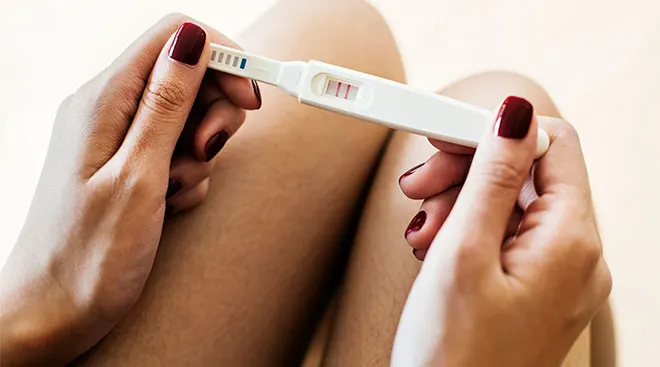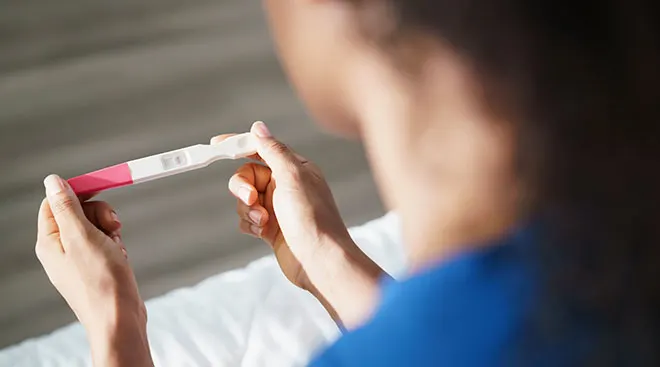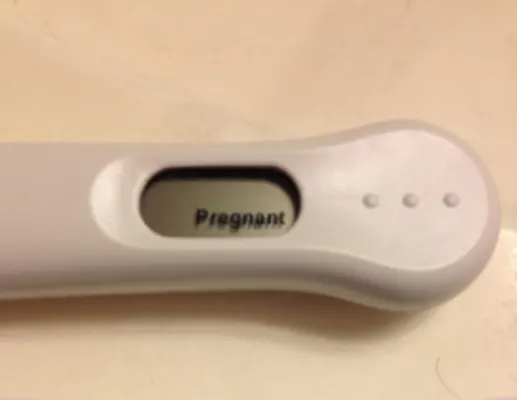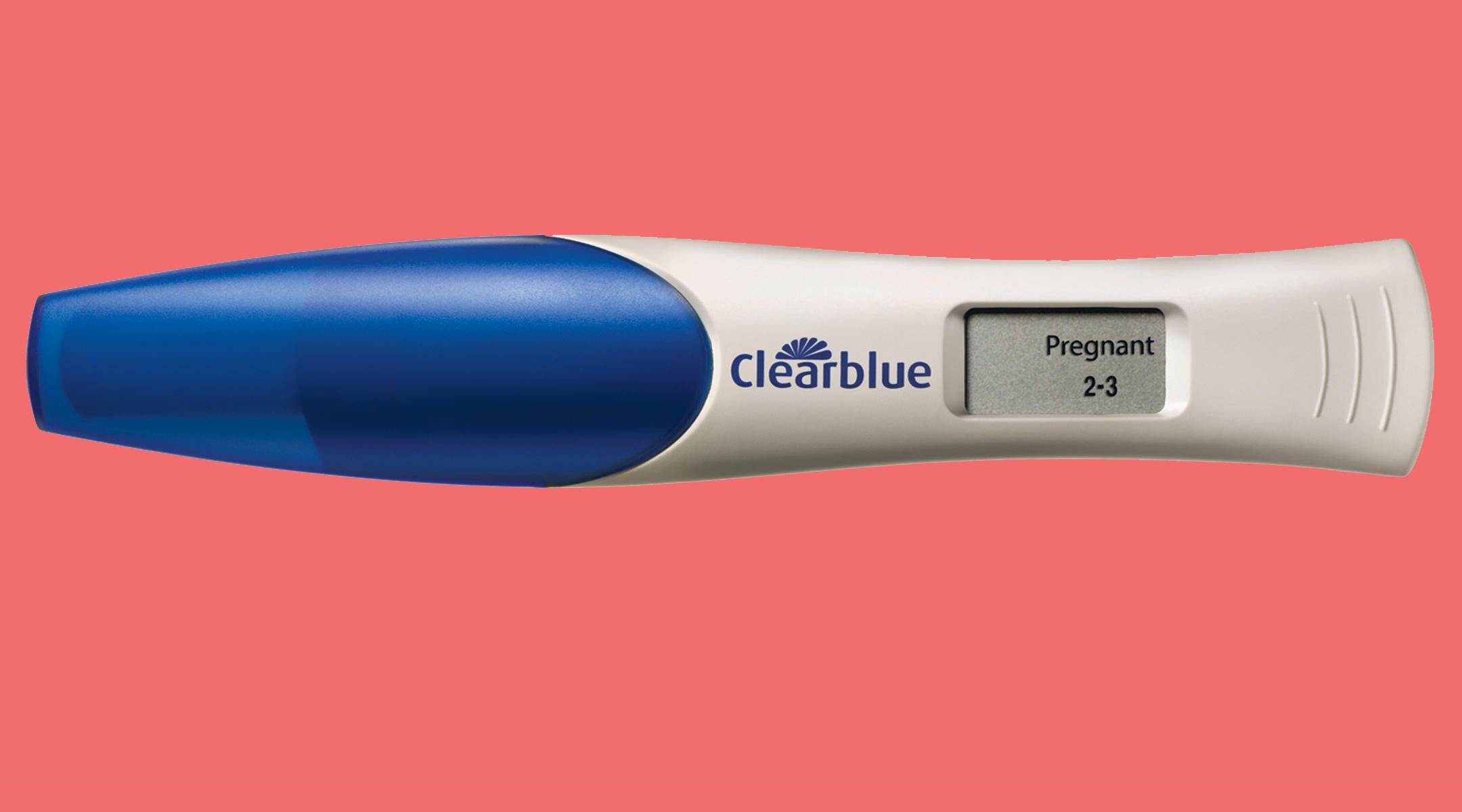How to Avoid Getting an Evaporation Line on a Pregnancy Test
If you’re taking an at-home pregnancy test, you might be feeling excited—and, let’s be honest, really nervous. The last thing you need are unclear results. But sometimes, it’s possible to confuse a faint line indicative of a positive result with an evaporation line, which doesn’t actually mean you’re pregnant.
So what is an evaporation line on a pregnancy test? Here’s what you should know about what evaporation lines look like, why they sometimes occur—and what you can do to avoid getting this confusing result.
Dye-based home pregnancy tests work by detecting the pregnancy hormone human chorionic gonadotropin (hCG) in your urine, says Kelli Burroughs, MD, a gynecologist in Houston. “The earliest a pregnancy can be detected is typically two weeks after conception,” she adds. “This timing correlates to the hCG levels reaching the threshold of 20 to 50 mIU/ml.”
The test is meant to show either a positive or negative result, with the second line typically indicating that you’re pregnant. “The dye-based tests work by chemically reacting and changing color when hCG is present,” says Maggie Tetrokalashvili, MD, an ob-gyn and chairperson of the department of obstetrics and gynecology at NYC Health + Hospitals/South Brooklyn Health in Brooklyn, New York. In addition to one or two lines, the result can also show the words “pregnant” or “not pregnant,” or a plus or minus sign, depending on the test kit. The first line is a control line, which displays regardless of whether you have a positive or negative result. The second line is a test line, and only pops up if you have detectable levels of hCG in your urine. This second line should be the same color as the control line, although it can range from very light to very dark depending on how much hCG there is in your body.
An evaporation line is a faint line that appears in the results window of an at-home pregnancy test. It can look very similar to a positive pregnancy test, since it forms in the same place as the test line (aka the second line that indicates a positive result). “This happens if the urine being tested has dried beyond the reaction time of the test,” says Tetrokalashvili.
I feel a little silly for getting my hopes up this morning. I took a test and there was no line. However, at certain angles, there was a shadow where a line would be if I was pregnant. It was gray and very faint… I knew it probably wasn't anything, but I'm still a little disappointed.
When urine sits on the test for too long past the reaction time, it’ll dilute and dry out, causing an evaporation line, Tetrokalashvili says. Many at-home pregnancy tests suggest reading the results within two, five or up to 10 minutes after you’ve peed on the stick. “An evaporation line happens when the pregnancy test is read after the time frame specified in the instructions,” Tetrokalashvili says. In short, an evaporation line is typically caused by user error. After all, there’s a reason the instructions dictate a certain window of time for viewing the results.
There are a few ways to determine whether that second line on your pregnancy test is an actual positive result or an evaporation line. Here’s a picture of a pregnancy test evaporation line for reference:
Consider the color of the line
Take a look at the color of the second line. “The difference between an evaporation line [and] a positive line is typically color. The evaporation line is usually a colorless line, while a faint positive line will have trace color,” Burroughs says.
Take a look at the thickness of the line
A faint positive pregnancy test result will usually have the same thickness and overall appearance as the control line. But an evaporation line may be thicker or more blurry, thinner or nearly undetectable, or it may even show up as an incomplete line.
Consider the timing
If you’re checking the result during the suggested time frame on the instructions, it’s more likely to be a faint positive result, Tetrokalashvili says. But if you notice the additional line much later on, it’s probably an evaporation line.
Why didn't I just buck up for a digital?! The test looked negative pretty fast. I got sidetracked and came back 15 minutes later; I glanced down at it and there was a line—a line! My train of thought after that: A line is a line, right? Gah! Am I ready to do this again?! Oh wait, about evaporation lines!
It’s likely that you want to avoid an evaporation line on a pregnancy test—you don’t want to add any more confusion and uncertainty to the whole overwhelming process, after all. “The best way to avoid an evaporation line is to check the results of a urine pregnancy test within five to 10 minutes of conducting the test and avoid drinking a large amount of water,” Burroughs says, since that can dilute the urine and skew results.
Tetrokalashvili shares a few additional tips you can follow in order to reduce the likelihood of getting an evaporation line on a pregnancy test:
- Check your results within the recommended time window on your test’s instructions (set a timer!)
- Try a digital at-home pregnancy test instead of a dye-based one, since those don’t have evaporation lines. It’ll simply present either a “pregnant” or “not pregnant” result
- Wait at least a day after your missed period to test so the test line won’t be quite so light if it is indeed positive
- Test first thing in the morning because your urine is more likely to have higher levels of hCG at that time
The best thing to do if you’re unsure whether your pregnancy test is positive or if you’re seeing an evaporation line is simply to take another test. Waiting at least a day after your missed period to test can help avoid getting a questionable result. Testing first thing in the morning, or the first time you use the bathroom on a given day, is also a good idea. But, if you’re still unsure whether it’s an evaporation line vs faint positive, it’s best to check with your doctor: They can perform a blood test, if necessary.
Monday's test had an evaporation line, but Wednesday's test was a true line and today's was even darker. I don't believe it—it’s amazing!
Frequently Asked Questions
How can you distinguish between an evaporation line vs. faint line?
“Urine pregnancy tests usually work by having antibodies that attach to pregnancy hormones bound to small [pink or blue] latex particles, explains Greg Marchand, MD, an ob-gyn and expert in minimally invasive gynecologic surgery in Arizona. "A ‘faint positive’ will be the color of those latex particles, which will be the same color as the control line.” An evaporation line, on the other hand, will be colorless or potentially have a slight yellow hue. The evaporation line is simply the small change in color or appearance of the area of the strip that was treated with the latex particles compared to the area of the strip that wasn’t. “When these areas are soaked in urine and then allowed to dry, there can be a small difference in appearance not caused by a positive test.”
How long does it take for an evaporation line to appear?
Marchand notes that he’s seen evaporation lines appear as soon as 10 minutes after a test was taken.
How common are evaporation lines on First Response tests?
If you read a test result after the recommended amount of time, evaporation lines are quite common. “For example, if you saved a pregnancy test you took in order to show a friend three hours later, it’s very likely an evaporation line will be present on the test line,” says Marchand.
Can an evaporation line have color?
A true evaporation line will be colorless or yellowish, and won’t have the same color as the control line, which is usually red or blue, explains Marchand, adding that, if a pregnancy test is left alone for a long time (days or weeks), it’s possible for bacteria to grow in the damp strip and change the color to something other than light yellow.
What are the distinguishing characteristics of a faint positive line?
A faint positive line will always have a hint of the color of the control line, says Marchand.
Can you get an evaporation line and still be pregnant?
Yes! “Most urine pregnancy strips are designed to detect a pregnancy hormone level of about gestational week 4—or 4 weeks after your missed period,” says Marchand. It’s entirely possible if you’re less than 4 weeks pregnant to have a negative test and still be very early in your pregnancy (too early to be detectable!).
It’s frustrating to see two lines on a pregnancy test and feel unsure whether it’s an evaporation line or a positive result. Follow the instructions on your test, and don’t wait to check the results.
Please note: The Bump and the materials and information it contains are not intended to, and do not constitute, medical or other health advice or diagnosis and should not be used as such. You should always consult with a qualified physician or health professional about your specific circumstances.
Plus, more from The Bump:
Kelli Burroughs, MD, is a gynecologist in Houston. She received her medical degree from Medical University of South Carolina.
Greg Marchand, MD, FACS, FICS, FACOG, is an ob-gyn and expert in minimally invasive gynecologic surgery, as well as the founder of the Marchand Institute for Minimally Invasive Surgery in Arizona. He leads the Society of Laparoscopic and Robotic Surgeons-accredited fellowship at Steward Health. He earned his medical degree from Spartan Health Sciences University in St. Lucia.
Maggie Tetrokalashvili, MD, is an ob-gyn and chairperson of the department of obstetrics and gynecology at NYC Health + Hospitals/South Brooklyn Health in Brooklyn, New York. She received her medical degree from First Moscow State Medical Institute.
Learn how we ensure the accuracy of our content through our editorial and medical review process.
Navigate forward to interact with the calendar and select a date. Press the question mark key to get the keyboard shortcuts for changing dates.





















































